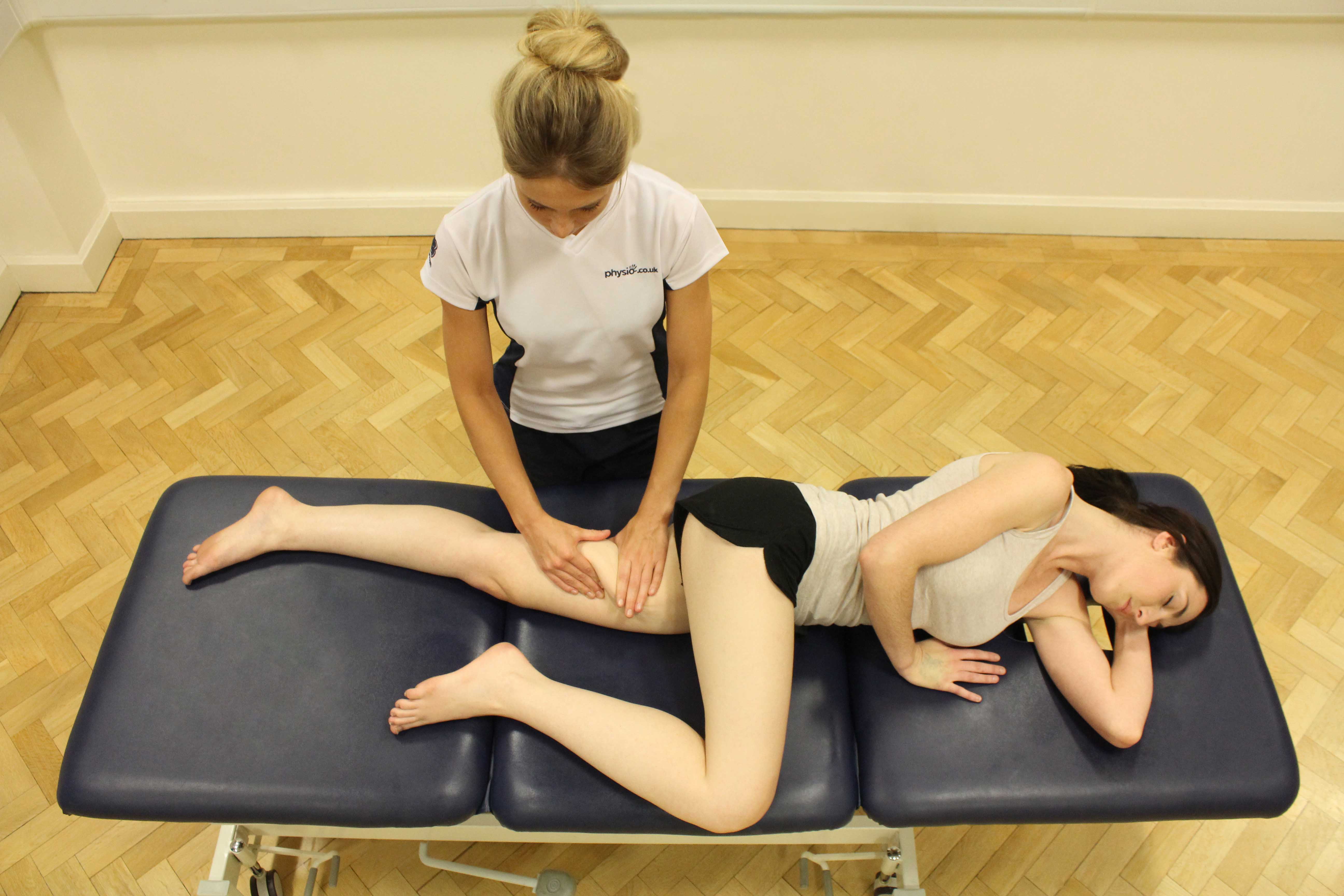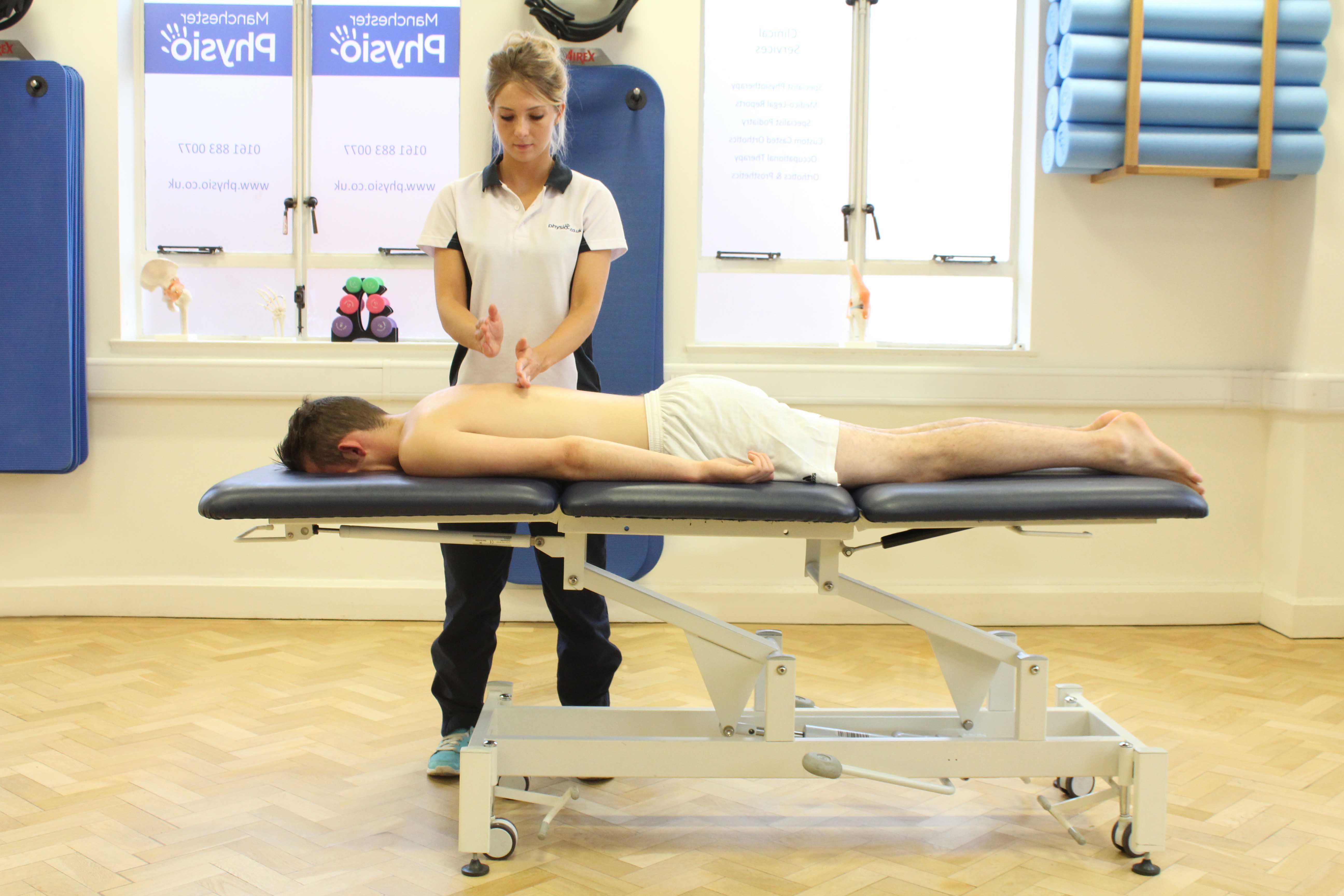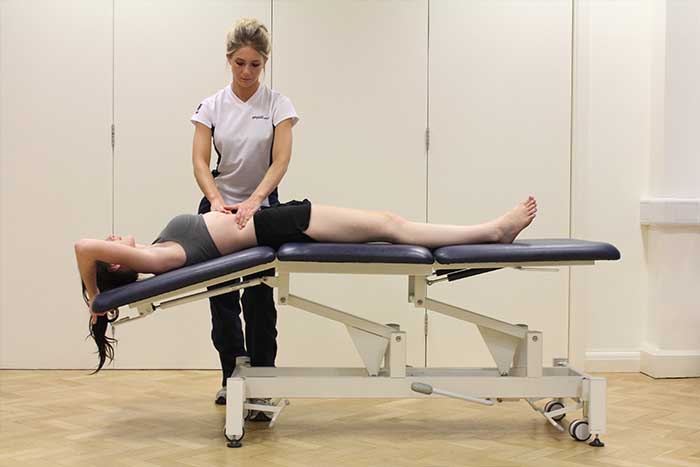Increased relaxation is a benefit regularly gained through massage. Relaxation can be increased both physically and mentally. Factors affecting relaxation include stress, tightness, tension and pain. Muscle tightness and tension restrict movement and increase pain. An increase in pain causes stress levels to increase which can further increase tightness and tension. Our massage therapists at Physio.co.uk increase relaxation through massage to help decrease pain, relieve muscle tightness and increase range of movement.
What are the most appropriate types of massage to increase relaxation?
A range of massage types can be used to increase relaxation. The most common types of massage used to increase relaxation include:
 Above: Soft Tissue Joint Massage, patellar mobilisations
Above: Soft Tissue Joint Massage, patellar mobilisationsThe massage types most commonly used to increase relaxation include remedial massage, Swedish massage and therapeutic massage.
A remedial massage is often used to increase relaxation. A remedial massage is where both superficial and deep tissues are manipulated to help increase relaxation and maintain their health. A remedial massage is commonly used to help increase the repair of damaged muscle fibres and tissues. Damaged muscle fibres and tissues often occur due to injury or surgery. Damaged muscles fibres and tissues cause an increase in pain preventing physical relaxation. Increasing the repair of muscle fibres and tissues through remedial massage helps to relieve pain more quickly and increase relaxation.

Swedish massage can be used to increase relaxation. A Swedish massage is used to relax muscles and remove metabolic wastes. The pressure used throughout a Swedish massage varies depending on personal preference. A Swedish massage encourages the relaxation of muscles by decreasing tension. Tension is where muscles stay in the state of contraction, preventing relaxation and restricting movement. A restriction in movement can increase stress levels preventing psychological relaxation. Reducing tension through Swedish massage to help increase muscle relaxation, also increases psychological relaxation by reducing stress and increases movement.
Relaxation is increased through therapeutic massage. A range of techniques are used throughout a therapeutic massage aiming to manipulate muscles into the state of relaxation. A therapeutic massage focuses on superficial muscles using a gentle pressure which can also vary depending on personal preference. The manipulation of muscles creates a therapeutic effect by increasing relaxation both physically and mentally. Muscles are encouraged to loosen, stretch and relax to relieve tension tightness and restriction, increasing relaxation physically. Relaxation is increased mentally by the encouragement of the release of positive hormones. Positive hormones increase relaxation and can give a person a sense of well-being, reducing stress and anxiety.
What techniques are used to increase relaxation?
A variety of techniques can be used to increase relaxation. The techniques most commonly used include:
 Above: Soft tissue massage of biceps brachii muscle
Above: Soft tissue massage of biceps brachii muscleThe most common techniques used to increase relaxation include effleurage, wringing and kneading.
Effleurage is regularly used to increase relaxation. Effleurage is a gentle technique that focuses mainly on soft tissues within superficial muscles. Effleurage is performed using flattened hands and fingers and is used to increase muscle temperature. Muscle temperature increases when effleurage is used, increasing tissue elasticity and flexibility. An increase in tissue elasticity and flexibility allows muscles to stretch increasing movement and relieving tightness and tension. Relieving tightness and tension increases relaxation.
Wringing is an effective technique used to increase relaxation. Wringing is where soft tissues are lifted and pulled from either side of the treatment area to the centre in opposite directions. Pressure varies from firm to light throughout the wringing movement aiming to stretch muscle tissues and relieve any restriction. Restriction can be caused by muscle tightness, tension and muscular knots. Muscle tightness, tension and muscular knots all cause an increase in pain and stress, reducing relaxation. The lifting and pulling movements used throughout wringing encourages muscle to stretch and loosen in order to relieve muscle tightness and tension and soften muscular knots. Softened muscular knots and a reduction in tightness and tension allows muscle relaxation to increase.
Kneading is often used to increase relaxation. Kneading involves the pulling and squeezing actions of areas containing soft tissues. Kneading aims to get into deeper layers of muscle tissues using a firm pressure throughout. Friction is created during kneading due to the pulling and squeezing actions. The friction created encourages an increase in blood flow to the area. An increase in blood flow is used to increase muscle temperature as well as provide an increase in healthy oxygen and nutrients to give a muscle energy and maintain its health. Muscle flexibility is increased when temperature rises, allowing the muscle to reach its full range of movement. Increasing range of movement and providing muscles with increased energy levels, reduces restriction and muscular fatigue and weakness therefore increasing muscle relaxation.

When can a massage help to increase relaxation?
Increasing relaxation through massage can help in various situations. The most common situations increased relaxation can help include:
Situations increased relaxation through massage can help include acute pain, pregnancy and stress.
Increasing relaxation through massage can help reduce pain. Pain can be caused by a variety of conditions. The most common causes of pain include muscle tightness, injury and overuse. When pain occurs, stress increases which can often further increase pain. During a massage relaxation of muscles occur due to increased temperature which improves tissue elasticity. Relaxation of muscles can reduce muscle tightness and the effect of injury and overuse therefore reducing pain. A massage also stimulates the release of endorphins, serotonin and dopamine which are positive hormones that reduce stress and increase relaxation. Reducing stress and increasing mental relaxation can help to further reduce pain.
Increased relaxation can help during pregnancy. During pregnancy, posture tends to become poor due to the added weight of the child. The spine often becomes more curved towards the middle meaning the belly sticks out whilst the shoulders are pulled backwards. This kind of posture can increase muscle tightness and pain and can often restrict movement. An increase in pain and restriction in movement can increase stress and make the pregnancy less enjoyable. A massage aims to loosen muscles to allow posture to slightly return to normal to help increase relaxation. A decrease in pain also reduces stress levels, further increasing relaxation. Positive hormones are also released during a massage. Positive hormones can give person a sense of well-being whilst also preventing depression, anxiety and the feeling of loneliness. Giving a person a sense of well-being can improve a person's mood making them happier and more relaxed.
Stress can be reduced when relaxation increases. Stress can be caused by pain, restricted movement and anxiety. A negative hormone called cortisol is the main hormone that causes stress to increase. Cortisol is released from the adrenal gland which is found on the top of the kidneys. As well as increasing stress, cortisol can cause depression, anxiety and can increase pain levels. A massage aims to reduce stress by replacing the negative hormones with positive hormones. Reducing the level of negative hormones circulating the body contributes to a decrease in pain and stress.
What are the physiological effects of massage to increase relaxation?
A wide range of physiological effects can occur during a massage to help increase relaxation. The physiological effects that most commonly occur include:
The most common physiological effects that occur to increase relaxation include increased temperature, increased endorphins, serotonin and dopamine and decreased cortisol.
Temperature increases during a massage to help increase relaxation. Increased temperature includes superficial tissues, deep tissues and fascia rising in temperature due to an increase in blood flow. An increase in blood flow occurs as friction is created between the skin and fingers during a massage. An increase in temperature is used to increase tissue elasticity to allow muscles to loosen and relax. When muscles are tight and tense, pain increases and relaxation decreases. Loosening muscles through increased temperature allows the muscles to relax decreasing muscle tightness and tension, relieving pain and increasing physical relaxation.
Relaxation is improved when endorphins, serotonin and dopamine levels increase. Within a massage, the autonomic nervous system is stimulated. The autonomic nervous system stimulates the release of endorphins, serotonin and dopamine which often act as neurotransmitters. Endorphins, serotonin and dopamine can give a person a feeling of happiness, relief of anxiety, and a sense of well-being. A massage encourages the release of the positive hormones to help decrease anxiety and prevent depression to encourage an increase in relaxation and motivation.
Decreased cortisol can help increase relaxation. Cortisol is a negative hormone the travels within the blood flow. Cortisol is released from the adrenal glands located on the kidneys in response to pain. Cortisol is responsible for increasing stress levels which can further increase pain. Cortisol is also known to increase anxiety and depression. Increased stress, anxiety and pain disables a person from both physically and psychologically relaxing. During a massage, friction created encourages the release of positive hormones serotonin, dopamine and endorphins. The positive hormones are used to replace cortisol. Replacing cortisol with positive hormones reduces stress, anxiety and pain levels and increases relaxation both physically and psychologically.
Summary
Increased relaxation involves both physical and mental relaxation of a person. A variety of massage types can be used to increase relaxation including remedial massage, Swedish massage and therapeutic massage. Massage techniques including effleurage, wringing and kneading can all be used to increase relaxation. Increasing relaxation through massage can help decrease pain, improve pregnancy and decrease stress. A range of physiological effects including increased temperature, increased endorphins, serotonin and dopamine and decreased cortisol all occur during a massage to help increase relaxation. Our massage therapists at Physio.co.uk increase relaxation through massage to help decrease restriction and give a person a sense of well-being.
How can I arrange a massage to increase relaxation?
The easiest way to arrange a massage to increase relaxation at Physio.co.uk is to email us at office@physio.co.uk or call us on 0800 033 7800.
You can also book an appointment online and save £10

 0330 088 7800
0330 088 7800






































